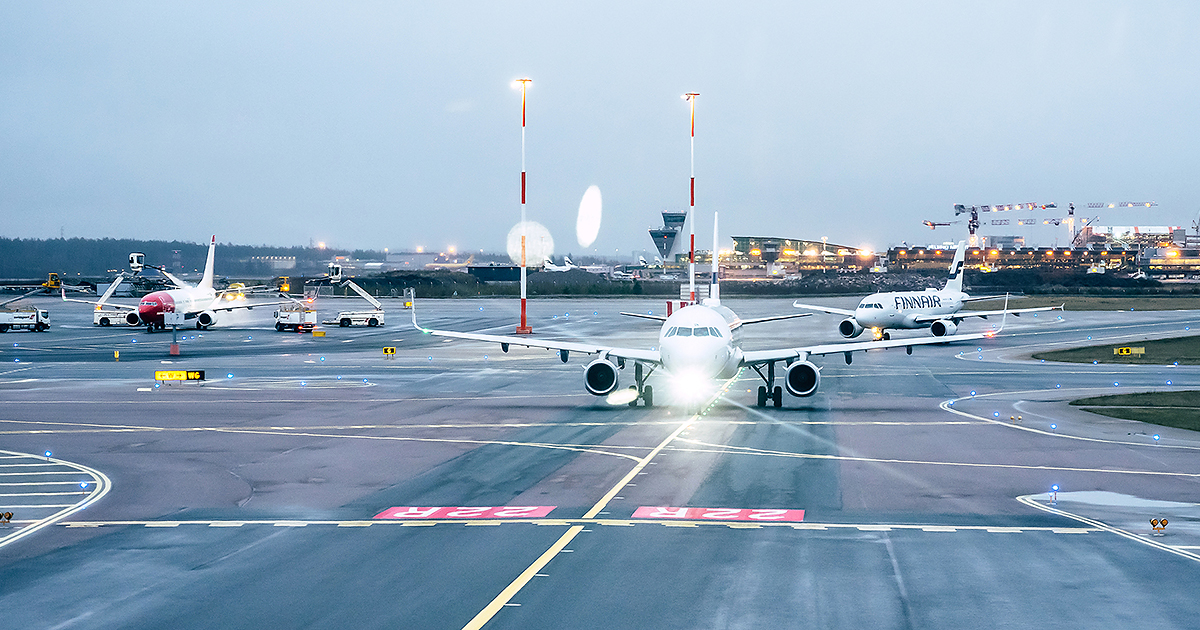Government decided on measures to reduce greenhouse gas emissions from aviation – focus on renewable aviation fuels and carbon pricing

The Government adopted a resolution on 6 May 2021 that confirms measures to reduce greenhouse gas emissions from aviation and the priorities for exerting influence internationally. The resolution draws on the work on the Roadmap for fossil-free transport.
The 2000s have seen a surge in emissions from aviation in Finland. It is estimated that without new measures the number of domestic flights and international air traffic departures will increase by 15 to 20 percent by 2030, and the amount of emissions from air traffic by 20 to 25 per cent compared to 2018. However, while the COVID-19 pandemic has deeply affected the sector, the volume of aviation is expected to continue rising soon both in Europe and globally.
According to the Government resolution, emissions from domestic air traffic and international air traffic departing from Finland will be reduced by 15 per cent from 2018 levels by 2030 and by 50 per cent by 2045. The emissions reduction target concerns emissions within the sector; in addition to these, aviation delivers emission savings in other sectors through various market mechanisms. Finland's domestic target is to be carbon neutral by 2045. In order to achieve the targets set in the Paris Agreement, we need effective measures to reduce emissions at the national level, in the EU and in the International Civil Aviation Organization (ICAO).
- Finland cannot alone eliminate global challenges, but through ambition and by setting an example we can contribute to the change at the international level. We have identified measures through which it is possible to reduce the carbon footprint of aviation, says Timo Harakka, the Minister of Transport and Communications.
Aviation accounts for about 2 per cent of emissions from domestic transport, but emissions from international aviation departing from Finland are considerably higher.
Focus on renewable fuels, energy efficiency and pricing
Emissions from aviation will be reduced by renewable fuels, energy efficiency and pricing. The Government resolution includes 23 measures.
It is more difficult to electrify aviation than passenger car traffic, which is why the introduction of renewable aviation fuels will be emphasised. The Government Programme aims to reduce emissions from aviation by introducing a blending mandate for renewable aviation fuels. Along with the implementation of the Government Programme, it will be assessed how the different levels of obligations influence the sector, as well as the more detailed ways to implement the obligations and international developments. Finland will also promote binding decisions in the EU and the ICAO to make renewable aviation fuels more widely introduced. As road transport becomes electrified, the use of renewable fuels should be steered by national and international decisions to aviation, as this will achieve the greatest climate benefits.
Energy efficiency can be promoted, in particular, by improving the functioning of airspace and by introducing emission-reducing flight methods. Finland supports the reform of the Single European Sky (SES) to encourage emissions reduction more efficiently than at present. In addition, by expanding the free routing airspace, flight routes can be shortened and emissions reduced. The State Travel Strategy will also be changed so that the volume of air travel will be reduced by using remote connections. In addition, environmental responsibility will be increased by favouring low-emission alternatives in state travel procurement.
The pricing of emissions can promote sustainable consumption. The countries of the world are committed to halting the growth of air traffic emissions to 2019 levels. This will be implemented through the Carbon Offsetting and Reduction Scheme for International Aviation (CORSIA), which entered into force in 2021, and to which Finland and the other 43 Member States of the European Civil Aviation Conference have acceded. In the future, it will be important, in international cooperation, to find ways to improve the efficiency of CORSIA's operations and, in other respects, to promote the pricing of greenhouse gas emissions from air traffic. Air transport was the first mode of transport to join the EU's emissions trading system in 2012.In 2021, the European Commission is expected to propose legislative amendments to increase the efficiency of emissions trading. The aim for Finland is that the free allocation of allowances of the emissions trading for air transport is gradually reduced and eventually abandoned altogether.
The Government also adopted a resolution, on 6 May 2021, on the Roadmap for fossil-free transport that is particularly relevant for road transport, and on reducing emissions from maritime and inland waterway transport.
What next?
The Ministerial Working Group on Climate and Energy Policy will monitor every six months the implementation of the resolution. The key indicator for this work is the statistics on air transport emissions by Statistics Finland.
Inquiries:
Requests for interviews with Minister Timo Harakka: Susanna Niinivaara, Communications Director, tel. +358 40 081 6187, susanna.niinivaara(at)lvm.fi
Janne Mänttäri, Senior Ministerial Adviser, tel. +358 40 069 3544, Twitter @janne_manttari; and Päivi Antikainen, Director of Unit, tel. +358 50 382 7101, Twitter @paiviantikainen
Valtioneuvosto.fi: Government resolution to reduce greenhouse gas emissions from aviation (in Finnish)
Gateway to Information on Government Projects Roadmap for fossil-free transport (LVM050:00/2019) (in Finnish)



